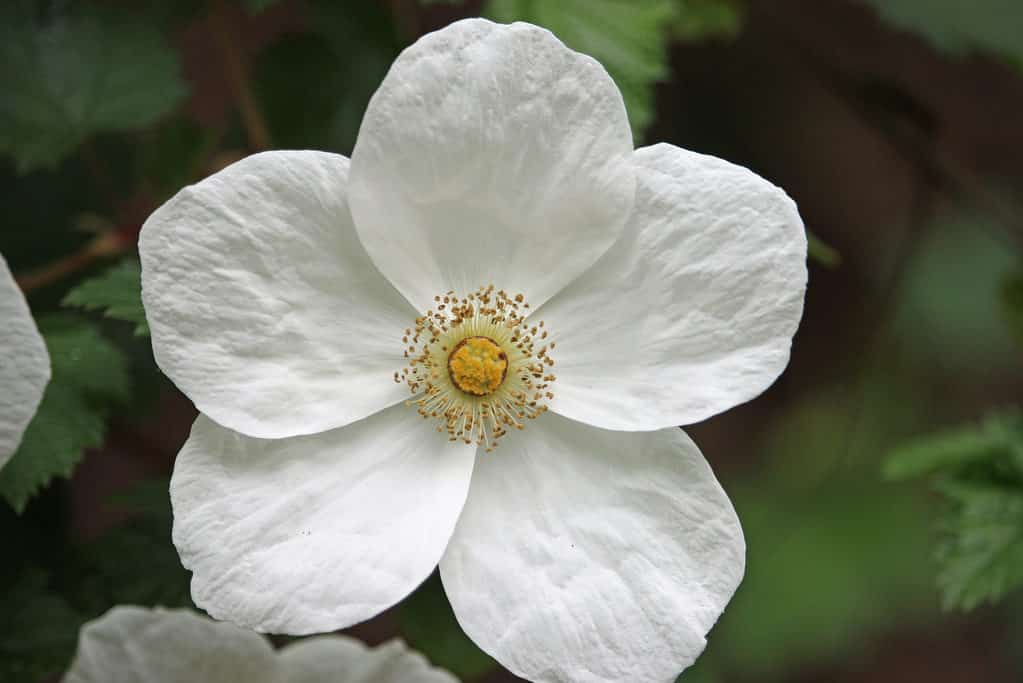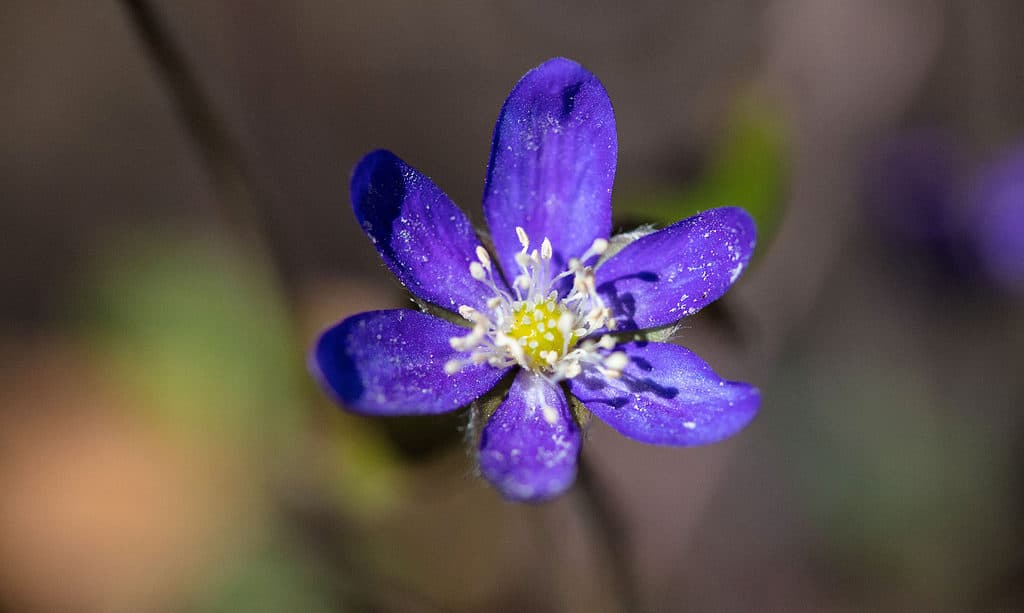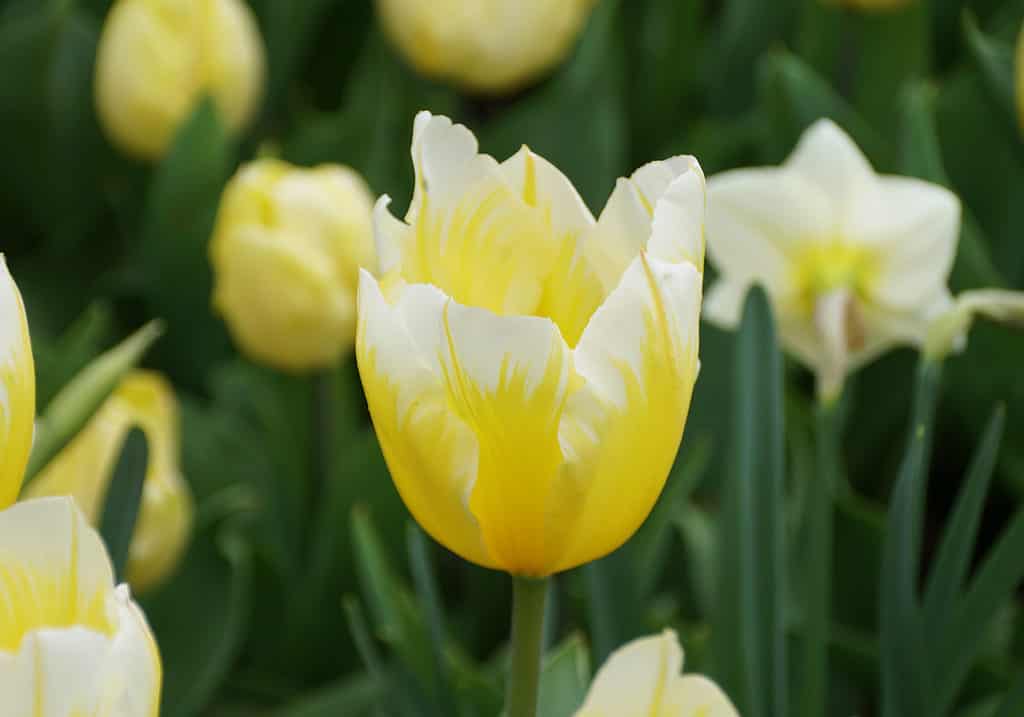Tulips and anemones are both highly prized for their unique coloring, beautiful looks, and the many uses they have. But what makes them so different? You’ll find both flowers practically anywhere in the world. Is there a reason for this? Let’s find out.

Close-up of a Grape-Leaved Anemone Bloom, one of the most familiar-looking anemones.
©JohnatAPW/Shutterstock.com
| Tulips | Anemones | |
|---|---|---|
| Classification | Tulipa, over 110 species, thousands of hybrids and cultivars | Anemone; roughly 200 species |
| Description | Tulips come in a wide range of colors, from striped shades of various colors to solids and bi-colors in red, white, pink, purple, orange, yellow, almost black, and more. They have 2 to 3 leaves. | Anemones have long leaf-stems and a wide range of both leaf forms and flower forms, with between 4 and 27 sepals. The flowers come in a range of shades, including red, almost black, blue, violet, pink, white, and bi-color. |
| Uses | Tulips are used as cut flowers and ornamental garden flowers, as well as herbal remedies for minor skin conditions like dry itch or minor insect bites or stings. The flowers and bulbs are also edible and so many appear in either cooked or raw salads and dishes, often replacing onions. | Anemones are grown in bee gardens, as ornamental flowers, and for cutting. They have been used for many things through the years in herbal medicine, but should never be used by non-professionals as they are toxic. |
| Origins and growing preferences | The tulip originates in Asia but has been cultivated in the Middle East since at least the 10th Century. The flower has more recently been cultivated in Europe, resulting in wild favor and the immense tulip industry today. They require full sun and well-draining soil to thrive. | Anemones originated in Japan but quickly spread throughout the world. They are naturalized or native in almost every country, save Australia and Antarctica. They require well-drained fertile sun and at least four hours of sunlight per day. |
| Fun facts and special features | Tulips have inspired artworks by many masters through the ages in paintings, drawings, textiles, and more. They have also been uniquely changed by aphids carrying a virus that created the striped varieties. Now, scientists create this effect through an artificial source of the virus DNA. | Anemones have legendary stories behind them dating back to Ancient Greece when Aphrodite fell in love with Adonis. They have been featured in a huge array of works, particularly notably Impressionists Matisse and Monet. |
Key Differences Between Tulips and Anemones
There are many differences between the two species of vibrantly colored flowers.
Tulips vs. Anemones: Classification

The blue anemone usually grows up to 2-12 inches.
©RP designs/Shutterstock.com
Tulips, or Tulipa as their known botanically, belong to the lily, or Liliaceae family. They are bulbous plants in about 100 species in the genus, and thousands of varieties, hybrids, and cultivars. They bloom in the springtime.
Anemone is both the common and the botanical name for this flower, though it is also known as Pasque flower, Pulsatilla, and Windflower. The genus Amemone contains about 200 flowering species and belongs to the Ranunculaceae family (the same family as the buttercup). The flower is native to almost everywhere in the world, save Australia and Antarctica. Some commonly cultivated species include wood anemones, snowdrop windflowers, meadow anemones (or Canada anemones) and Grecian windflowers.
Tulips vs. Anemones: Description

The Irene Parrot Tulip is a good example of a striped, multi-colored tulip.
©Teo Wei Keong/Shutterstock.com
Whether self-colored (solids) or “broken” (striped), tulips come in a huge array of colors and flower forms. From fringed edges to straight edges, from multi-colored to solids, the beautiful plant is one of the most favored in the world for its appearance. The flower may come in purple, red, white, orange, yellow, green, cream, peach, tangerine, pink, purple, violet, almost black, lilac, and almost any other shade you can think of except true blue. The plant has two to three leaves that cluster at the base of the plant, usually a blueish-green shade, and the flowers have petals, sepals, and stamens.
Anemones have basal leaves and long leaf-stems that may either be upright or prostrate. The leaves may be compound or simple, with lobed, undivided, or parted leaf blades, and margins that may be entire or toothed. The flowers have between 4 and 27 sepals, depending on the variety, with 2 to 9 flowers per plant. Anemones also come in a wide range of colors, including white, pink, purple, red, blue, violet, almost black, and bicolor.
Tulips vs. Anemones: Uses

Wood anemones are vibrant and thrive in a wide range of settings.
©iStock.com/yuelan
Tulips are prized the world over for their incredible beauty, coming in a huge array of colors and forms. The flowers are grown in cutting gardens, ornamental gardens, and bee gardens, as well as herbal gardens. The flower and bulbs are actually both edible and used in salads and dishes, either cooked or raw. They replace onions, thanks for their zingy flavor. They are also poultices for insect bites and stings, dry itchy skin, minor wounds, and other similar minor skin conditions. The red tulip is crushed and used as a natural cosmetic both as a concealer and as a rouge.
Anemones have largely been grown as ornamental flowers. They are native in much of the world, so they make for excellent additions to bee gardens, as bee gardens thrive with native plants in them. Anemones are perennials also planted in many ornamental gardeners. Some of the species are drought resistant, as well, and so they often find their way into xeriscaping. They are often used as cut flowers and in bouquets, as potted plants, and in container gardens. Additionally, anemones have long been used in herbal remedies and folk medicine. Only experts should ever do so, though, as the plant is actually toxic. Scientists have been able to treat various deadly conditions through careful use of the plant. Never use the plant yourself for home remedies.
Tulips vs. Anemones: Origins and Growing Preferences

Tulips come in a huge array of colors and forms.
©Khairil Azhar Junos/Shutterstock.com
While the tulip is known to have originated in Central Asia, it is generally believed that cultivation of the flower began specifically in Persia (Iran) in the 10th Century. The plant eventually became the symbol of the Ottoman Empire, they were so beloved there. To this day, the flower is the national flower of both Turkey and Iran. In modern cultivation, through which we got the many, many varieties we have today, the tulip industry was birthed in the Netherlands. A botanist named Carolus Clusius began growing the bulbs when he received some, treasuring them highly. However, his garden was broken into and bulbs stolen, thus beginning the demand for the vibrantly colored flowers in popular culture.
Tulips require full sun and well-draining soil. They should never get soggy, as their bulbs will rot. The bulbs should be planted 4 to 6 inches apart, at least 6 to 8 inches deep, with the pointed end of the bulb upward. Water the bulbs immediately after planting and keep the soil moist without soaking it.
Anemone flowers originated in Japan but spread throughout Europe. The anemone flower has been a part of fascination since at least ancient Greece, when the flower came into play in the legend of Aphrodite and Adonis (more on this below). The flowers have a home in many legends and stories and are considered homes of the fairy folk. The flowers were worn in the Middle Ages as a protection against pestilence and disease, though in other cultures, like China and Egypt, the blue varieties are associated with death.
There are two general types of anemones: tuber-rooted anemones and rhizome anemones. Both require well-drained, fertile soil. Tubers should be planted about three feet deep and five inches apart. Both require regular watering without waterlogging and at least four hours of sunlight per day.
Tulips vs. Anemones: Special Features and Fun Facts

Hot honey rag tulips are beautiful flowers with a silly name.
©praneem79/Shutterstock.com
There’s a surprising number of intriguing facts about most flower species and genera. In this case, both the tulip and the anemone have pretty fascinating things in their history and legend.
- Tulips first came to Europe in the 1500s. Within less than 100 years, their popularity had enormously, creating a phenomenon that became known as Tulip Mania. The craze between 1634 and 1637 drove prices to exorbitant levels and ultimately crashed the market when the bulbs were largely sold at the same time, dropping their value.
- Anemones have been associated with fragility dating back to the Victorian era’s “language of flowers.” The flowers are given symbolic meanings in this language, with unspoken messages and secrets. The gorgeous flower is paired with loyalty, fragility, and love because of the Greek myth of Aphrodite and Adonis who were lovers. When Adonis was slain, Aphrodite wept for him, and where those tears fell and mingled with his blood, anemones bloomed.
- Tulips have been the source of inspiration for many artworks throughout the history of their cultivation. Islamic artwork has depicted the flowers since the time of sultans, European artists have used the flowers to create designs on textiles and furniture, and German painter, Jacob Marrel is particularly known for creating a book of tulip paintings depicting the varieties for sale. Tulips have since continued to be heavily used in many other forms of artwork, including photography and crafts.
- Anemones, too, have been featured in a wide array of artworks. Impressionists Matisse and Monet, for example, both depicted the flowers in their works. For many artists, the flower has a religious tone and has been used to represent the blood of Christ in paintings of the Crucifixion, often with the Virgin Mary mourning alongside him.
- Tulips come in a huge array of colors, and each color is said to represent a meaning or message. Orange tulips symbolize mutual understanding and affection, red tulips express love and romance. White tulips are the apology flower, while yellow tulips denote happiness.
- The anemone also has many meanings. They have been used as good luck charms, warding off evil and ill wishes. They are a symbol of forgotten love and affection or the loss of a loved one. Some think they ward off illness and disease. They also imply the approaching rain by closing up their petals.
- Striped tulips are not natural. Their stripes were first due to a virus by aphids. When scientists finally discovered this in 1931, they began purposefully recreating the virus synthetically to use for cultivating striped tulips without the use of aphids.
- The word “anemone” comes from the Greek word that means windflower, or rather “daughter of the wind.” The delicate flowers earned the name because the wind blows away the petals easily when they fall.
The photo featured at the top of this post is ©
Thank you for reading! Have some feedback for us? Contact the AZ Animals editorial team.






